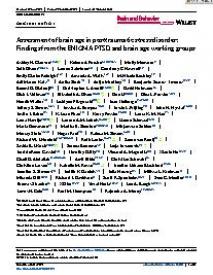Assessment of brain age in posttraumatic stress disorder : Findings from the ENIGMA PTSD and brain age working groups
Background: Posttraumatic stress disorder (PTSD) is associated with markers of accelerated aging. Estimates of brain age, compared to chronological age, may clarify the effects of PTSD on the brain and may inform treatment approaches targeting the neurobiology of aging in the context of PTSD.
Method: Adult subjects (N = 2229; 56.2% male) aged 18–69 years (mean = 35.6, SD = 11.0) from 21 ENIGMA-PGC PTSD sites underwent T1-weighted brain structural magnetic resonance imaging, and PTSD assessment (PTSD+, n = 884). Previously trained voxel-wise (brainageR) and region-of-interest (BARACUS and PHOTON) machine learning pipelines were compared in a subset of control subjects (n = 386). Linear mixed effects models were conducted in the full sample (those with and without PTSD) to examine the effect of PTSD on brain predicted age difference (brain PAD; brain age − chronological age) controlling for chronological age, sex, and scan site.
Results: BrainageR most accurately predicted brain age in a subset (n = 386) of controls (brainageR: ICC = 0.71, R = 0.72, MAE = 5.68; PHOTON: ICC = 0.61, R = 0.62, MAE = 6.37; BARACUS: ICC = 0.47, R = 0.64, MAE = 8.80). Using brainageR, a threeway interaction revealed that young males with PTSD exhibited higher brain PADrelative to male controls in young and old age groups; old males with PTSD exhibited lower brain PAD compared tomale controls of all ages.
Discussion: Differential impact of PTSD on brain PAD in younger versus older males may indicate a critical window when PTSD impacts brain aging, followed by age-related brain changes that are consonant with individuals without PTSD. Future longitudinal research is warranted to understand how PTSD impacts brain aging across the lifespan.
In: Brain and Behavior ; ISSN: 2162-3279 | e2413
https://onlinelibrary.wiley.com/doi/10.1002/brb3.2413


